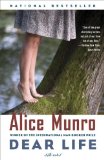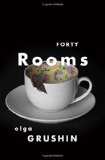Summary | Excerpt | Reading Guide | Reviews | Beyond the book | Read-Alikes | Genres & Themes | Author Bio

Stories
by Alice MunroEdgar Allan Poe defined the short story as a piece of literature that should be able to be read in a single - yet relatively long and leisurely - sitting. Contemporary short stories have recently been shifting toward a shorter format than what Poe outlined in the nineteenth century. Trends like "short short stories" and "flash fiction" are made for busy, fast-moving readers. In some ways, Alice Munro's stories, which move at a leisurely pace, at times seemingly unconcerned with plot, harken back to Poe's longer, classic style of short fiction. Each one asks that the reader slow down and absorb every word, lest one miss a key motion or detail that advances the subtle narratives.
Dear Life, Munro's latest collection, explores the relentless passing of time and its influence on parents, children, and lovers. In "Train," which is almost startling with its power, a young man escapes his future by jumping off of a train and into the squalor of an old lady's life. In this and some of the other stories, we can see Munro linking the conservative, secretive small town - with reclusive, laconic denizens - to her larger preoccupation with time. In "Amundsen," which first appeared in The New Yorker, a young teacher at a tuberculosis sanatorium is challenged by the sanatorium doctor in the slight, suggestive manner that Munro's characters often use when confronting sexuality, violence, and trauma.
Munro is strikingly modern with her approach in Dear Life, as she concludes the collection with a quartet of stories that are, as she writes in the preface, "autobiographical in feeling, though not, sometimes, entirely so in fact." These pieces are reflective and emotive and based in memory rather than imagination. New readers may find it easiest to enter the quiet, thoughtful world of Alice Munro through these final four pieces. For readers who are already familiar with Munro's work, these four stories will offer a glimpse of this writer's foundational moments - epiphanies, ambiguities, verisimilitude - that drive her writing. That Munro has chosen to share these personal qualities through the magnifying lens of her fiction writing makes the experience all the more enriching.
Munro writes with an almost invisible, crystalline style that rarely incorporates common literary devices like simile or metaphor. The height of her flourish is a bit of repetition or delicate hints of colloquial, everyday language, such as when the young teacher in "Amundsen" thinks about the doctor who is so critical the nurses say he'll "tear a strip off you" or Munro's mother in "The Eye" believes that her daughter "worships" the babysitter. These subtle uses of metonymy and colorful language make the dialogue deceptively simple and startlingly realistic. This clarity allows for a closer proximity to the characters, who speak and act in the straightforward manner of a moment or memory rather than the formality of a performance. This clarity, though, should not be mistaken for simplicity, for Munro relies on small actions to speak loudly, which enables them to unfold slightly differently with each reading.
Throughout Dear Life, Munro continues to present worlds where the small and quiet things ring with loud purpose. In the opening story, "To Reach Japan," for example, after the dramatic events of their railroad trip, a young girl lets go of her mother's hand while standing on a train platform. The reader can now see how this small action shows the girl's transition from a quiet observer at the beginning of the story, to one who has chosen to separate herself from her mother's choices.
To say that these are short stories feels almost dismissive, as the content is long, sometimes life-spanning, and is rarely framed in the singular fashion of many contemporary short stories. In this regard they are truly stories that are worth a long, leisurely sitting, as Poe once said they should be.
Alice Munro talks about Dear Life with The New Yorker.
![]() This review was originally published in The BookBrowse Review in January 2013, and has been updated for the
July 2013 edition.
Click here to go to this issue.
This review was originally published in The BookBrowse Review in January 2013, and has been updated for the
July 2013 edition.
Click here to go to this issue.

If you liked Dear Life, try these:

by Edna O'Brien
Published 2017
Collected here for the first time are stories spanning five decades of writing by the "short story master." (Harold Bloom)

by Olga Grushin
Published 2016
The internationally acclaimed author of The Dream Life of Sukhanov now returns to gift us with Forty Rooms, which outshines even that prizewinning novel.






Your guide toexceptional books
BookBrowse seeks out and recommends the best in contemporary fiction and nonfiction—books that not only engage and entertain but also deepen our understanding of ourselves and the world around us.